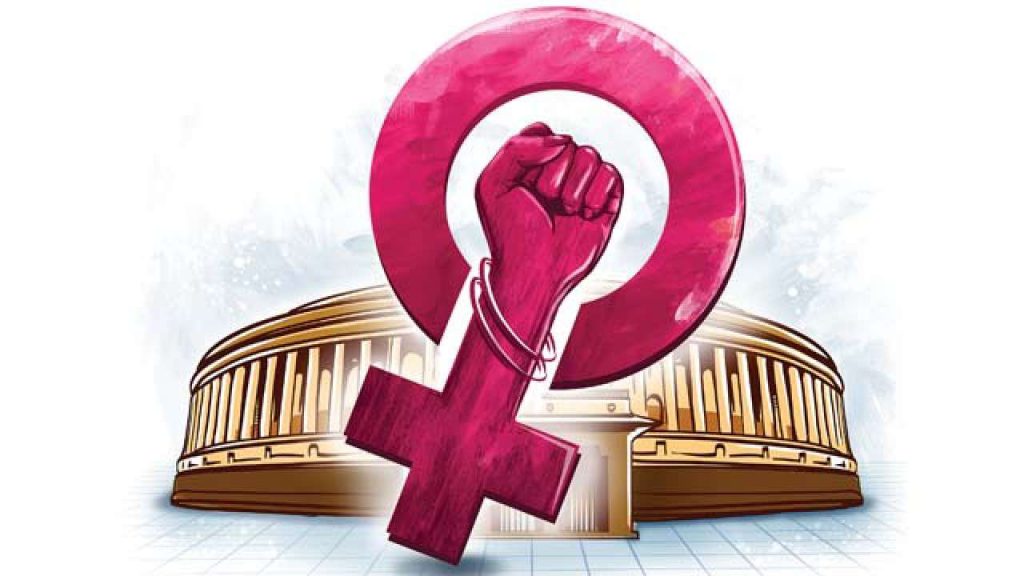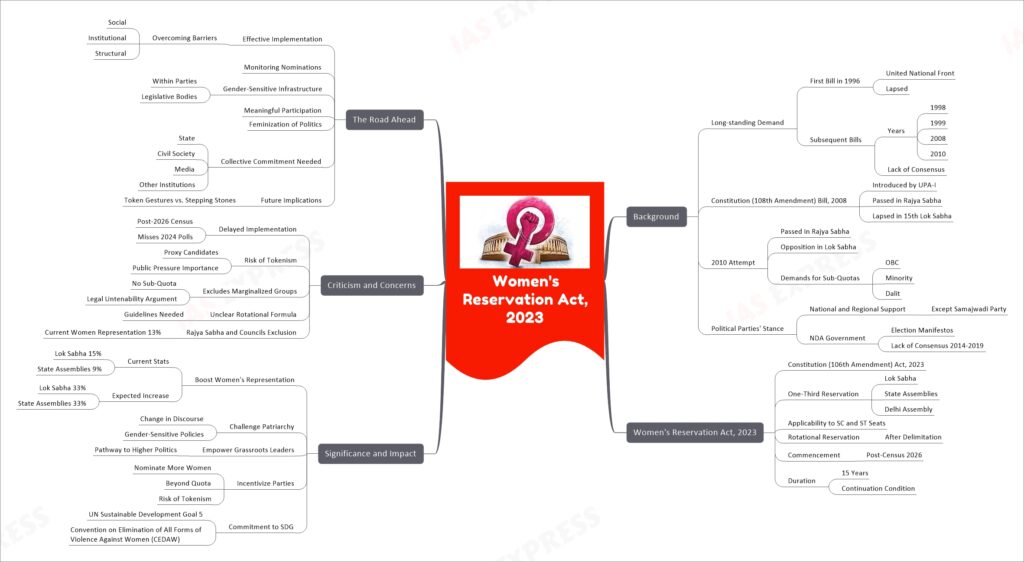Women’s Reservation Act, 2023: A Landmark Step Towards Gender Equality in Indian Politics

From Current Affairs Notes for UPSC » Editorials & In-depths » This topic
IAS EXPRESS Vs UPSC Prelims 2024: 85+ questions reflected
The passage of the Women’s Reservation Bill, 2023, now known as the Women’s Reservation Act, 2023 or the Nari Shakti Vandan Adhiniyam, marks a historic moment in India’s journey towards gender equality in politics and governance. The Act reserves one-third seats in the Lok Sabha and state legislative assemblies for women for a period of 15 years. This is expected to significantly boost the representation of women in Parliament and state assemblies.
Background of the Women’s Reservation Bill
The demand for reserving seats for women in elected bodies has been long-standing in India. The first Bill proposing to reserve one-third seats in Lok Sabha for women was introduced in 1996 during the United National Front government, but it lapsed. Similar Bills were brought in 1998, 1999, 2008, and 2010, but did not become law due to lack of political consensus.
In 2008, the UPA-I government introduced the Constitution (108th Amendment) Bill to reserve one-third seats in Lok Sabha and state assemblies for women. The Bill was passed in the Rajya Sabha but lapsed after the dissolution of the 15th Lok Sabha. In 2010, the Women’s Reservation Bill was again introduced and passed in the Rajya Sabha amid protests. But the Bill could not be passed in the Lok Sabha due to opposition from some regional parties. There were demands for sub-quotas for OBC, minority, and Dalit women.
Over the years, almost all major national and regional parties, except Samajwadi Party, have supported the legislation. However, they could not arrive at a consensus on various aspects of the Bill including sub-quotas. The NDA government listed the Women’s Reservation Bill in its election manifestos but did not table it in Parliament from 2014-2019 due to lack of political consensus.
Key Features of the Women’s Reservation Act, 2023
The key features of the Women’s Reservation Act, 2023 are:
- It amends the Constitution [Constitution (106th Amendment) Act, 2023] to reserve one-third seats for women in Lok Sabha, state legislative assemblies, and Delhi Legislative Assembly.
- The one-third reservation will also apply to seats reserved for SCs and STs.
- The reservation for women will be rotated after every delimitation exercise. Delimitation is the redrawing of constituencies based on population data from the latest census.
- The reservation will come into force after the first census post the commencement of the Act. The census exercise is currently on hold and is expected to be held in 2026. Based on fresh census data, delimitation will be conducted to determine seats to be reserved.
- The reservation will be provided for an initial period of 15 years. However, it will continue till Parliament makes a law to terminate it.
Significance and Impact
The passage of the Women’s Reservation Bill, 2023 is a landmark achievement for the women’s rights movement in India. It is expected to significantly boost the political representation of women and promote their participation in decision-making. Some of the key impacts are:
1. Boost Women’s Representation in Parliament and Assemblies
As of 2022, women’s representation in the Lok Sabha and state assemblies is only 15% and 9% respectively, much below the global average of 25%. With the passage of this Bill, women’s representation is set to witness a quantum leap. When implemented, 181 out of 543 seats (33%) will be reserved for women in Lok Sabha. Similarly, one-third seats in all state assemblies will be reserved. This is a major fillip for gender equality in Indian democracy.
2. Challenge Patriarchy and Change Public Discourse
The under-representation of women in politics is a reflection of the deeply entrenched patriarchy and gender bias in Indian society. The presence of more women legislators will challenge traditional patriarchal mindsets and make political discourse more gender-sensitive. With more women in legislatures, policies are also likely to be more responsive to women’s perspectives and needs.
3. Empower Women Grassroots Leaders
Women’s reservation at the panchayat and urban local bodies has resulted in the emergence of many grassroots women leaders from marginalized sections. The Women’s Reservation Act will provide a pathway for more such grassroots leaders to enter state-level and national politics. It will create a pipeline of women leaders and change the male-centric political culture.
4. Incentivize Parties to Nominate More Women
To fill the women’s quota, political parties will be incentivized to actively scout for and nominate more women candidates beyond the reserved constituencies. This can gradually increase women’s overall representation beyond the 33% quota. However, some experts argue that parties may treat women candidates as tokens limited to reserved seats. Sustained advocacy would be required to address this.
5. India’s Commitment to Women Empowerment Goals
The passage of the Women’s Reservation Bill reinforces India’s commitment to the UN Sustainable Development Goals, especially Goal 5 on achieving gender equality. India is a signatory to the Convention on Elimination of All Forms of Violence Against Women (CEDAW) which recommends at least 30% seats for women. The new legislation brings India closer to fulfilling its international commitments.
Criticism and Concerns
While the Women’s Reservation Bill has been largely welcomed, some concerns and criticism have also been raised:
1. Delayed Implementation
The legislation states that the 33% reservation will come into force only after delimitation based on the 2026 census. This implies that its implementation may get pushed to 2029, missing the 2024 Lok Sabha polls. The opposition has criticized this delay calling it a betrayal of women.
2. Risk of Tokenism
Some experts argue that parties may treat women as tokens by limiting them to reserved seats alone. Women candidates may be given tickets from losing constituencies. This may reinforce the trend of proxy candidates where male relatives contest in the name of female candidates. Sustained public pressure would be vital to address this.
3. Excludes OBC and Minority Women
The Women’s Reservation Bill does not provide any sub-quota for OBC, minority, Dalit or Adivasi women within the 33% quota. This has led to demands for compartmentalized reservations to ensure the representation of women from all social groups. The government has argued that being a Constitution Amendment Bill, sub-categorization is legally untenable.
4. No Clarity on Rotational Formula
While the Act states reserved seats will rotate between constituencies after delimitation, the exact formula for rotation is unclear. Some experts argue that the rotation should be based on the proportion of social groups in respective constituencies. Clarity is needed on the guidelines for rotational reservation.
5. Rajya Sabha and Legislative Councils Excluded
The 33% reservation does not apply to the Rajya Sabha and Legislative Councils (where they exist). In Rajya Sabha, women have only 13% representation currently. This gap in the legislation has also attracted criticism.
The Road Ahead
The passage of the Women’s Reservation Bill, 2023 is undoubtedly a milestone moment. However, effective on-ground implementation remains a challenge. Sustained advocacy would be vital
to address concerns around delayed implementation, tokenism and exclusion of marginalized women. Monitoring the nomination and support to women candidates by political parties needs to be strengthened. Most importantly, the infrastructure and environment within parties and legislative bodies have to be made more gender-sensitive. The presence of more women legislators must lead to meaningful participation, impactful representation, and a shift in institutional culture.
The journey does not end with the passage of legislation. The road ahead would involve overcoming social barriers, institutional resistance, and structural discrimination that constrain women’s entry and participation in electoral politics. The passage of the Women’s Reservation Act opens up new vistas for gender justice and equality. But the actual realization of its transformative potential would depend on the collective commitment and sustained efforts of the state, civil society, media, and other institutions. Only time will tell whether the newly reserved seats for women turn out to be mere token gestures or stepping stones towards the feminization of Indian politics and policymaking.
Practice Question for Mains
Evaluate the potential impact of the Women’s Reservation Act, 2023 on the political representation of women in India. Discuss the challenges and opportunities it presents. (250 words)
Frequently Asked Questions
Q1. When will the 33% reservation for women come into force?
The Women’s Reservation Act states that the 33% quota will come into effect after delimitation of constituencies based on the 2026 census data. This would imply that the earliest it can be implemented is for the 2029 Lok Sabha polls.
Q2. How many Lok Sabha seats will be reserved for women?
Out of the total 543 elected seats in the Lok Sabha, 181 seats (33%) will be reserved for women candidates when the Act is implemented.
Q3. Will the reservation apply to Rajya Sabha and Legislative Councils?
No, the 33% quota is only applicable to the Lok Sabha, state legislative assemblies, and the Delhi assembly. It does not extend to the Rajya Sabha and states’ Legislative Councils.
Q4. Can the reservation period be extended beyond 15 years?
Yes, while the Act provides reservation for 15 years initially, this can be continued beyond 15 years by a law passed by Parliament. The reservation shall continue until Parliament decides to terminate it through legislation.
Q5. Will the reserved seats for women rotate?
Yes, the legislation states that seats reserved for women shall rotate between constituencies after every delimitation exercise as per the formula determined by Parliament.
If you like this post, please share your feedback in the comments section below so that we will upload more posts like this.



How can it lead to criminalization of politics ???
Please read that line again. It says, that this issue “diverts attention from” electoral reforms such as Criminalization of politics and inner party democracy. We didn’t mention “lead to”. Hope I clarified your doubt.
What are disadvantage of women reservation